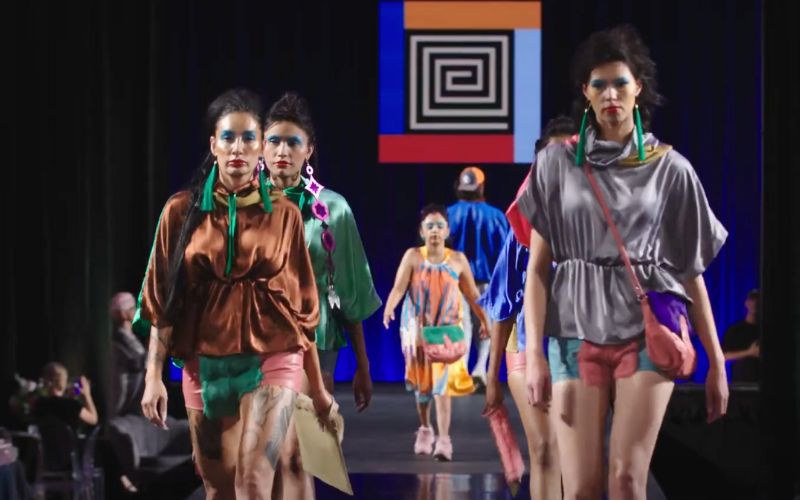
- Details
- By Kaili Berg
The event is set to take place from May 2 to 5 and will feature Native American and Indigenous Canadian designers who aim to shine a spotlight on their unique fashion narratives and celebrate the rich diversity in Indigenous cultures.
The line up of Native American and Indigenous Canadian designers include:
- Carrie Wood "chizhii"
- Dehmin Cleland
- Himikalas Pamela Baker of T.O.C Legends
- House of Sutai by Peshawn Bread
- Justin Jacob Louis
- Lesley Hampton
- Loren Aragon of Towering Stone
- Maria Hupfield
- Orlando Dugi
- Patricia Michaels
- Qaulluq
- Randy Leigh Barton
- Victoria's Arctic Fashion
Additional designers and special guests will be revealed in the next few months on SNFW’s Instagram account.
The event will commence with a media launch at the New Mexico Governor’s Mansion on May 2, 2024. The following day, a fashion mini-symposium will be held at a location that is yet to be determined, where panel discussions will range over topics such as “Why Native American Fashion Matters?” and a “Designer-Focused Fashion Hub”.
The weekend will bring mainstage fashion shows, trunk shows, and brand activations. These brand activation spaces will provide opportunities for organizations to engage with diverse communities and enhance their visibility in the fashion industry.
Tickets will be available to purchase in March 2024. The SWAIA is currently offering sponsorship opportunities and activation spaces.
Since SWAIA launched its Indigenous Fashion Show in 2014, its shows have grown tremendously. It is now a highlight of the Santa Fe Indian Market, the largest American Indian arts festival in the world, attracting Indigenous fashion designers from all over North America.
Designers for that monumental day were Orlando Dugi, Sho Sho Esquiro, Jamie Okuma and Bethany Yellowtail. The late World Championship Hoop Dancer, Nakotah LaRance, opened the show, performing with the DJ playing A Tribe Called Red in the background.
“Santa Fe Indian Market has always been about showcasing and making sure our artists have that same voice and that includes fashion. That is a really important voice to me because that’s representation and that’s something our cultures have struggled with and have been invisible for so many years,” SWAIA Executive Director Jamie Schulze told reporter Darren Thompson in a previously published article by Native News Online.
“It is important for us to come out as the creatives that we have always been historically, not only through our jewelry, our sculpture, and these amazing art pieces, but what we wore,” Schultz said.
More Stories Like This
What Inspires Indigenous Ballet Dancer Jock SotoGrand Rapids Public Museum Hosts Indigenous Culture Celebrations
In Case You Missed It: Native Bidaské - Julian Brave NoiseCat on His New Book “We Survived the Night”
Santa Ynez Band of Chumash Indians to Host 19th Annual Culture Day on October 18
Cherokee Nation Collaborates with DreamWorks and NBCUniversal to Bring Cherokee-Language Dub of How to Train Your Dragon
Help us tell the stories that could save Native languages and food traditions
At a critical moment for Indian Country, Native News Online is embarking on our most ambitious reporting project yet: "Cultivating Culture," a three-year investigation into two forces shaping Native community survival—food sovereignty and language revitalization.
The devastating impact of COVID-19 accelerated the loss of Native elders and with them, irreplaceable cultural knowledge. Yet across tribal communities, innovative leaders are fighting back, reclaiming traditional food systems and breathing new life into Native languages. These aren't just cultural preservation efforts—they're powerful pathways to community health, healing, and resilience.
Our dedicated reporting team will spend three years documenting these stories through on-the-ground reporting in 18 tribal communities, producing over 200 in-depth stories, 18 podcast episodes, and multimedia content that amplifies Indigenous voices. We'll show policymakers, funders, and allies how cultural restoration directly impacts physical and mental wellness while celebrating successful models of sovereignty and self-determination.
This isn't corporate media parachuting into Indian Country for a quick story. This is sustained, relationship-based journalism by Native reporters who understand these communities. It's "Warrior Journalism"—fearless reporting that serves the 5.5 million readers who depend on us for news that mainstream media often ignores.
We need your help right now. While we've secured partial funding, we're still $450,000 short of our three-year budget. Our immediate goal is $25,000 this month to keep this critical work moving forward—funding reporter salaries, travel to remote communities, photography, and the deep reporting these stories deserve.
Every dollar directly supports Indigenous journalists telling Indigenous stories. Whether it's $5 or $50, your contribution ensures these vital narratives of resilience, innovation, and hope don't disappear into silence.
 The stakes couldn't be higher. Native languages are being lost at an alarming rate. Food insecurity plagues many tribal communities. But solutions are emerging, and these stories need to be told.
The stakes couldn't be higher. Native languages are being lost at an alarming rate. Food insecurity plagues many tribal communities. But solutions are emerging, and these stories need to be told.
Support independent Native journalism. Fund the stories that matter.
Levi Rickert (Potawatomi), Editor & Publisher

